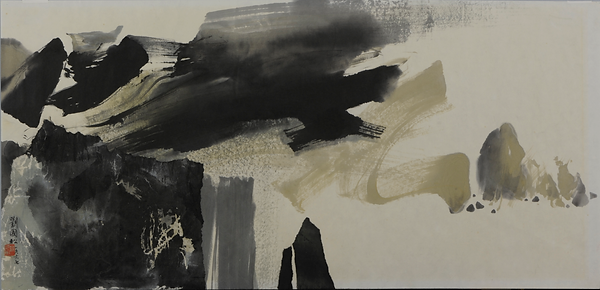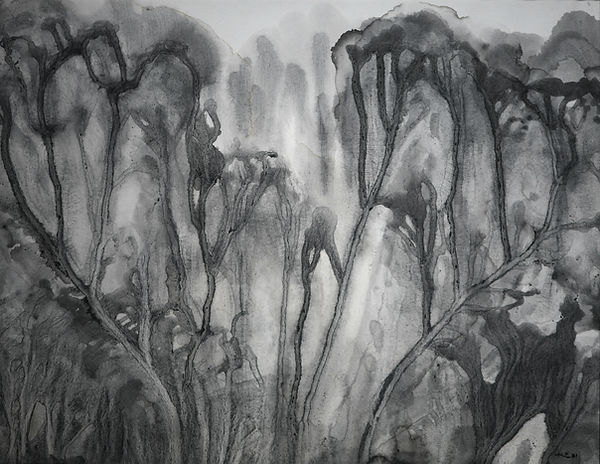Modern ink art: Experiments of abstraction and ink art without ink

Liu Kuo-sung (Liu Guosong)
(Taiwanese, born in Anhui, China, 1932)
Peaks in Contemplation
1967
Ink wash on paper
18 x 37 1/4 in.
Gift of Charles Read
During the early 1960s, Liu Kuo-sung began his exploration to create modern abstract art inspired by Chinese ink painting to reinvigorate this artistic tradition. He conducted a variety of experiments in painting techniques and styles, incorporating elements of Chan Buddhism and cursive calligraphy in his pursuit of a modern Chinese ink painting with a global perspective. Here, Liu adapts the tradition of landscape painting into an ambiguous topography made up of bold brushstrokes and seemingly organic forms. This work was created a few years before Liu first visited the University of Iowa in 1975 as a visiting professor. Liu’s time in Iowa marks the encounter between UI and one of the most important Chinese artists of the 20th century.

Hu Hung-shu (Taiwanese American, born in Shanghai, China, 1935-2015)
Separated
1981
Oil on canvas
44 x 34 in
Gift of Judy Hu
2023.17
Hu Hung-shu (Taiwanese American, born in Shanghai, China, 1935-2015)
Soaring
1983
Oil on canvas
34 x 38 in.
Gift of Judy Hu
2023.19

Hu Hung-shu (1935-2015) was a Taiwanese American architect, designer, sculptor, painter, and educator. Born in Shanghai, China and educated in both China and Taiwan, Hu went abroad to the United States in 1964 to pursue another degree.[1] Hu’s degrees include a B.S. in architecture from Cheng-kung University and an M.F.A. in design from the Cranbrook Academy of Art.[2] In 1966, Hu started teaching design at the University of Northern Iowa, where he would stay until 1968.[3] Hu then took over the new design program for the School of Art and Art History at the University of Iowa until 2003, after which he retired.[4] While he excelled in many areas, Hu’s paintings consistently went on exhibition in the U.S. and made appearances in France, South Korea, and Taiwan.[5]
Hu’s Soaring and Separated in this exhibition on ink art are of interest to us. Despite lacking actual ink, both paintings express Hu’s desire to combine traditional Chinese ink painting with modern practices to create a type of modern Chinese ink painting that explores abstraction. Hu wished to defy the norms of traditional Chinese ink painting which typically uses water-based ink on paper and/or silk.[6]
From here, Hu experimented with the traditional medium by using oil paints mixed with water on canvas and also with techniques for applying paints. These techniques produced paintings that showcased no noticeable traits of the typical tools used in painting. Hu allowed the paints to flow freely on the canvas, responding to gravity, or he would even blow the paint. These techniques would create natural images with little human manipulation.[7] In Soaring, viewers can see that the paint was blown, especially regarding the light shape, darkly outlined on the upper left-hand side. Separated is representative of the use of gravity in Hu’s process, as viewers can see by the vertical lines that adorn the canvas. These modern ideas join with traditional Chinese ink painting using a water and pigment mixture, and strict adherence to black and white elemental colors to create modern Chinese ink paintings.[8]
Another modern idea that Soaring and Separated utilize is abstraction. Hu, like other modern ink painters in China, aimed to extract the essence of a form when attempting abstraction. He was avoiding complete abstraction, something often seen in works by artists like Jackson Pollock. While at first glance viewers may be reminded of complete abstraction, Hu is pulling imagery of landscapes in through organic [9] For example, looking at Soaring, one may be reminded of clouds, water, or even rock formations. Separated may be reminiscent of trees in a forest or flowers growing among the grass. While we can recognize the appearance of abstraction here, we also see aspects of traditional Chinese ink painting through this evocative imagery comparable to Chinese landscape [10] Hu’s paintings are therefore also representative of an abstract movement among modern Chinese artists.
Aly Hurley
[1] Robert Albright Rorex, “Hung-shu Hu Paintings: 1975-1995,” in Hu Hung-shu Oil Painting Solo Exhibition: New Techniques and New Artistic Concepts, ed. Lin Manyuan (Taiwan: Taiwan Provincial Museum of Art, 1985), 16-19.
[2] “About,” Hu Hung-shu, accessed November 22, 2024, http://www.huhungshu.com.
[3] Xu Jing-yue, “Beyond the Definitions of ‘Tradition’ and ‘Modernity’: The Painting World of Hu Hung-shu,” in A Thousand Views and a Million Scenes: Hu Hung-shu Modern Oil Painting Exhibition, ed. Yeh Yuiseng, Huang Shihfeng, Kang Jill, et al. (Taiwan: Chan Liu Art Museum, 2006), 14-17.
[4] Rorex, “Hung-shu Hu Paintings: 1975-1995,” 16.
[5] Xu, “Beyond the Definitions of ‘Tradition’ and ‘Modernity’: The Painting World of Hu Hung-shu,” 15.
[6] Rorex, “Hung-shu Hu Paintings: 1975-1995,” 17.
[7] Huang Cheng-zhi, “Meeting Point of the West and the East: A Review on Prof. Hu Hung-shu’s Oil Paintings,” in A Thousand Views and a Million Scenes: Hu Hung-shu Modern Oil Painting Exhibition, edited by Yeh Yuiseng, Huang Shihfeng, Kang Jill, et al. (Taiwan: Chan Liu Art Museum, 2006), 5.
[8] Rorex, “Hung-shu Hu Paintings: 1975-1995,” 18.
[9] Rorex, “Hung-shu Hu Paintings: 1975-1995,” 18.
[10] Rorex, “Hung-shu Hu Paintings: 1975-1995,” 17.
Ink Painting Without Ink – Between Realms
Ink painting (shuimo hua) as a genre has long been used synonymously with Chinese painting (guohua) itself.[1] For centuries, the ink and brush stood steadfastly at the center of China’s artistic tradition, determining the aesthetics and techniques that make up the historically respected canon. Then, at the onset of the twentieth century, their emblematic significance was only solidified with their sharp contrast to Western-style painting (xihua) and its use of watercolor and oil. The tension in this dichotomy has at times blinded art historians to the nuanced complexities of the artistic exchange between the so-called East and West; but it has also inspired Chinese artists to push past these strictly defined realms of tradition and modernization to create art that transcends all cultural expectations.
The systematic introduction of Western art in China at the beginning of the twentieth century attempted to maintain distance between Chinese tradition and encroaching Western schools.[2] Chinese artists were trained in either ink or oil, the Chinese tradition or Western style respectively. Their artistic identities were also subsequently defined by this binary; they were bound to work only in one medium or the other for their entire careers. Even artistic exhibitions, criticism, and scholarship of the time were defined by their focus on either guohua or xihua, but never both. They remained, by all accounts, entirely separate artistic realms – worlds apart, even in the same city.
However, by the 1980s, there was an explosion of new avant-garde art groups and exhibitions in China dedicated to modernizing Chinese art based on Western models.[3] Though this Art New Wave movement was constrained by its strictly linear view of artistic exchange, it successfully encouraged Chinese artists to critically reevaluate the taboos, techniques, and subjects of traditional guohua for the first time. Reactions to the Art New Wave were complex and remain difficult to succinctly trace to modern art movements. Artists and scholars alike rallied behind the banner of modernization at the movement’s conception, but their interpretations of modernity in the context of Chinese tradition varied widely.
Ink painter Wu Guanzhong, whose essays are largely credited with inciting these critical reflections of Chinese art, centered his own argument for modernization in direct opposition to Chinese socialist art. The rigid expectations of socialist China outlined a specific list of acceptable subjects for Chinese artists, placing emphasis on content rather than form.[4] Wu emphatically rejected these restrictions, declaring that individual expression and abstract beauty are at the core of artistic creation and should therefore not be limited by political agendas. Many of Wu’s contemporaries agreed with this general principle, using the traditional ink and brush for a variety of new genres and subjects – a movement many critics now refer to as modern ink painting. Yet, while these artists succeeded in liberating the ink and brush from the constraints of the past, they had yet to fully transcend the East-West dichotomy. Painting Western subjects in ink did not remove the rigid boundaries between these cultures but simply reimagined them as flexible lines.
To fully embrace complete artistic freedom, Chinese artists had to turn away from this binary of cultural mediums and explore the universal language of emerging experimental art forms. While some Chinese artists had already ventured into the realms of installation and performance art as early as the 1950s, the Chinese art world catapulted into an era of experimentation following the fusion (ronghe) trend of the 1980s. Rather than remain bound to the idea that ink is necessary to create ink painting, modern Chinese artists are exploring the artistic innovations that lie beyond and between the confines of medium and tradition.[5] Installations by artists such as Liu Jianhua and Xu Bing evoke ink drips and brushstrokes in unconventional materials such as industrial debris, fabric, and lights. Additionally, performance art pieces like those of Song Dong, which gained incredible popularity after the turn of the century, draw from the inherent performativity of calligraphy. In this way, Chinese artists’ experimentation in alternative mediums, are new expressions of a continuous tradition – a new lens through which to view the potential of the past.
This uniquely retrospective quality of contemporary experimental ink art is what gives them their beauty and power. Modern Chinese artists are inspired by their nation’s cultural history, not because they seek to recreate it, but because they recognize how it can be completely reimagined in today’s global landscape.[6] Innovative works like these would not exist, let alone be so striking, without their haunting similarity to Chinese ink art of the past. The two Hu Hung-shu paintings in this exhibition – Soaring and Separated – are incredible examples of this new way of interpreting tradition. The abstract, monochromatic landscapes Hu Hung-shu creates use oil paint to evoke the delicate movement of ink. Yet, his works do not represent a linear exchange between two sole cultures and mediums; rather, they express one artist’s distinctive vision, brought to life through the intersecting planes of past and present, old and new. Afterall, do the running lines of Separated not echo the sloping peaks in Scenery on the San-tu Pass? And do the bleeding forms in Soaring not mirror the swirling forms in a calligrapher’s water dish? Even in the abstract and experimental, there are remnants of material truth, the ever-present trace of sacred tradition.
Anna Ottavi
[1] Wu Hung, “Transcending the East / West Dichotomy: A Short History of Contemporary Chinese Ink Painting,” in Ink Art: Past as Present in Contemporary China, edited by Maxwell K Hearn and Wu Hung (New York: Metropolitan Museum of Art, 2013), 19.
[2] Wu, “Transcending the East / West Dichotomy,” 19.
[3] Wu, “Transcending the East / West Dichotomy,” 20.
[4] Wu, “Transcending the East / West Dichotomy,” 20.
[5] Sarah E. Fraser, “Beyond Ink: Contemporary Experimental Ink Art,” in Xu Bing: Beyond the Book from the Sky, edited by Sarah E. Fraser and Yu-Chieh Li (Singapore: Springer, 2020), 60.
[6] Fraser, “Beyond Ink,” 65.
